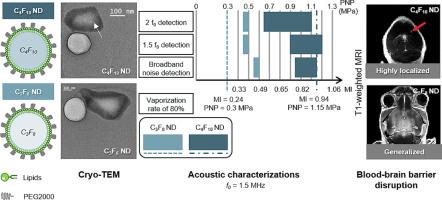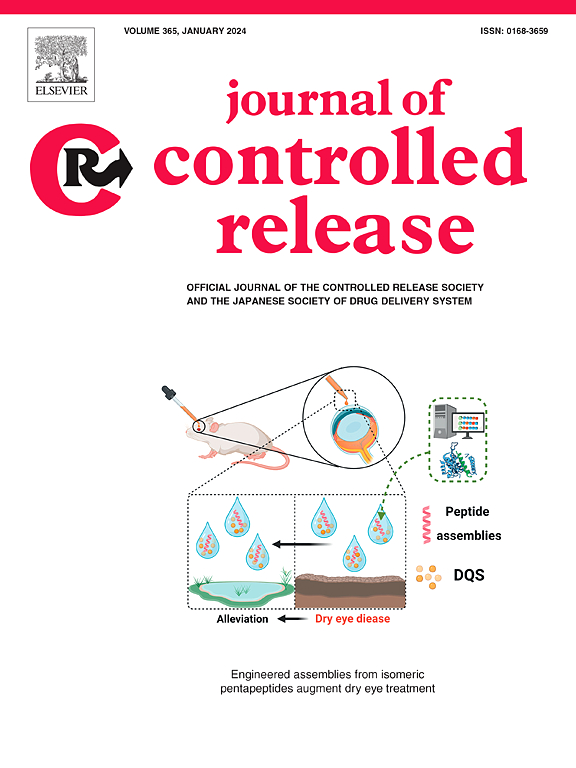低沸点全氟碳化物纳米微滴,用于适应超声波诱导的血脑屏障开放。
IF 10.5
1区 医学
Q1 CHEMISTRY, MULTIDISCIPLINARY
引用次数: 0
摘要
低沸点全氟碳化物纳米液滴(NDs)是一种有效的声敏剂,它封装了一种液态全氟碳化物,如果没有 NDs 外壳,这种液态全氟碳化物会在体温下瞬间蒸发。这些 NDs 已被用于治疗和诊断目的。在此,我们对由微气泡缩合形成的含八氟丙烷(C3F8)或十氟丁烷(C4F10)的磷脂壳纳米小滴进行了彻底的表征,然后再进行血脑(BBB)渗透。利用透射电子显微镜(TEM)和低温透射电子显微镜(cryo-TEM)确认了液滴的形成,同时通过冷凝后的电子密度观察评估了液滴表面和脂质排列的高分辨率。利用高速照相机测定了 NDs 的汽化阈值,并通过空化检测分析了新汽化气泡发出的频率信号。C3F8 NDs 在 0.3 MPa(f0 = 1.5 MHz,50 个周期)时出现气化,从 0.45 MPa 开始发出 2 f0 和 1.5 f0 的信号(f0 = 1.5 MHz,50 个周期),而从 0.55 MPa 开始测量到宽带噪声。沸点较高的 C4F10 ND 在 1.15 兆帕斯卡时汽化,从 0.65 兆帕斯卡开始发出 2 f0 信号,从 0.9 兆帕斯卡开始发出 1.5 f0 信号,而从 0.95 兆帕斯卡开始检测到宽带噪声。利用定制的超声序列,这两种 ND 配方都被用于渗透健康小鼠的 BBB,从而确定了每种 ND 的最佳应用。事实证明,C3F8 ND 适用于在低声压条件下渗透大面积区域(可能是整个大脑),而且安全可靠。同时,C4F10 液滴可在较高压力下实现非常局部(400 微米各向同性)的渗透。这项研究促使人们对微气泡凝结成 NDs 过程中发生的结构重排进行更深入的研究,并凸显了通过选择 NDs 的成分和调整超声波序列为不同的脑部病理定制解决方案的潜力。本文章由计算机程序翻译,如有差异,请以英文原文为准。

Low-boiling-point perfluorocarbon nanodroplets for adaptable ultrasound-induced blood-brain barrier opening
Low-boiling point perfluorocarbon nanodroplets (NDs) are valued as effective sonosensitive agents, encapsulating a liquid perfluorocarbon that would instantaneously vaporize at body temperature without the NDs shell. Those NDs have been explored for both therapeutic and diagnostic purposes. Here, phospholipid-shelled nanodroplets containing octafluoropropane (C3F8) or decafluorobutane (C4F10) formed by condensation of microbubbles were thoroughly characterized before blood-brain (BBB) permeabilization. Transmission electron microscopy (TEM) and cryo-TEM were employed to confirm droplet formation while providing high-resolution insights into the droplet surface and lipid arrangement assessed from electron density observation after condensation. The vaporization threshold of NDs was determined with a high-speed camera, and the frequency signal emitted by the freshly vaporized bubbles was analyzed using cavitation detection. C3F8 NDs exhibited vaporization at 0.3 MPa (f0 = 1.5 MHz, 50 cycles), and emitted signals at 2 f0 and 1.5 f0 from 0.45 MPa onwards (f0 = 1.5 MHz, 50 cycles), while broadband noise was measured starting from 0.55 MPa. NDs with the higher boiling point C4F10 vaporized at 1.15 MPa and emitted signals at 2 f0 from 0.65 MPa and 1.5 f0 from 0.9 MPa, while broadband noise was detected starting from 0.95 MPa. Both ND formulations were used to permeabilize the BBB in healthy mice using tailored ultrasound sequences, allowing for the identification of optimal applications for each NDs type. C3F8 NDs proved suitable and safe for permeabilizing a large area, potentially the entire brain, at low acoustic pressure. Meanwhile, C4F10 droplets facilitated very localized (400 μm isotropic) permeabilization at higher pressure. This study prompts a closer examination of the structural rearrangements occurring during the condensation of microbubbles into NDs and highlights the potential to tailor solutions for different brain pathologies by choosing the composition of the NDs and adjusting the ultrasound sequence.
求助全文
通过发布文献求助,成功后即可免费获取论文全文。
去求助
来源期刊

Journal of Controlled Release
医学-化学综合
CiteScore
18.50
自引率
5.60%
发文量
700
审稿时长
39 days
期刊介绍:
The Journal of Controlled Release (JCR) proudly serves as the Official Journal of the Controlled Release Society and the Japan Society of Drug Delivery System.
Dedicated to the broad field of delivery science and technology, JCR publishes high-quality research articles covering drug delivery systems and all facets of formulations. This includes the physicochemical and biological properties of drugs, design and characterization of dosage forms, release mechanisms, in vivo testing, and formulation research and development across pharmaceutical, diagnostic, agricultural, environmental, cosmetic, and food industries.
Priority is given to manuscripts that contribute to the fundamental understanding of principles or demonstrate the advantages of novel technologies in terms of safety and efficacy over current clinical standards. JCR strives to be a leading platform for advancements in delivery science and technology.
 求助内容:
求助内容: 应助结果提醒方式:
应助结果提醒方式:


